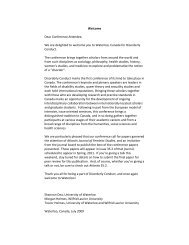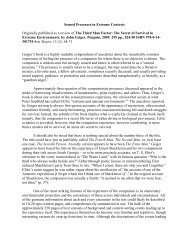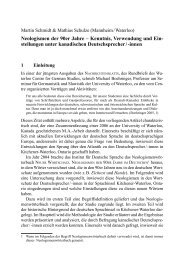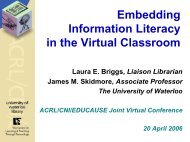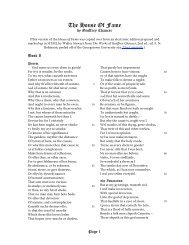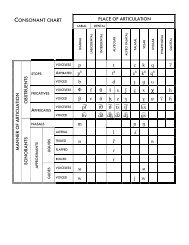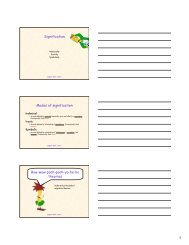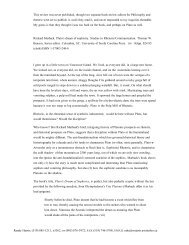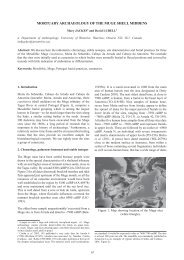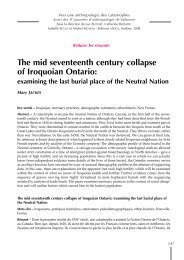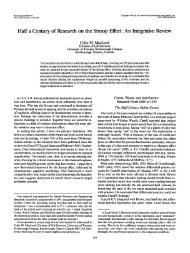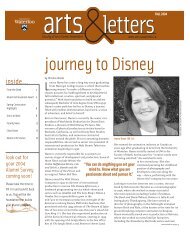Individual Differences in Learning and Memory: A Unitary ...
Individual Differences in Learning and Memory: A Unitary ...
Individual Differences in Learning and Memory: A Unitary ...
Create successful ePaper yourself
Turn your PDF publications into a flip-book with our unique Google optimized e-Paper software.
DIFFERENCES IN LEARNING AND MEMORY 539<br />
preferred measure of ability were sizable, despite the restricted range of<br />
her subjects on the ability test. Yen’s study illustrates a successful<br />
model-specific approach to study<strong>in</strong>g differences <strong>in</strong> LTS characteristics.<br />
Furthermore, it is an elegant demonstration of the value of a well-<br />
specified model <strong>in</strong> <strong>in</strong>vestigat<strong>in</strong>g <strong>in</strong>dividual differences <strong>in</strong> learn<strong>in</strong>g <strong>and</strong><br />
memory.<br />
Another model-dependent approach was alluded to earlier, that used by<br />
MacLeod et al. (1978) to exam<strong>in</strong>e strategy choice <strong>in</strong> perform<strong>in</strong>g a<br />
sentence-picture verification task (e.g., to verify that PLUS ABOVE<br />
STAR is false with respect to T, cf. Carpenter & Just, 1975). Depend<strong>in</strong>g<br />
on a subject’s spatial ability, two qualitatively different models applied.<br />
For 27% of the subjects (16 of 59), the task seemed to be performed as if<br />
compar<strong>in</strong>g holistic images; these were the subjects high <strong>in</strong> spatial ability.<br />
The rema<strong>in</strong><strong>in</strong>g 43 lower-spatial subjects used a more analytic comparison<br />
process described as l<strong>in</strong>guistic <strong>in</strong> nature. Cooper (Note 2) has found a<br />
strik<strong>in</strong>gly similar pattern <strong>in</strong> her studies <strong>in</strong>volv<strong>in</strong>g comparison of figural<br />
shapes. The subjects whose strategy she calls Type I “could be compar-<br />
<strong>in</strong>g a visual memory representation with a test shape <strong>in</strong> a holistic, parallel<br />
fashion,” while the subjects us<strong>in</strong>g the Type II strategy “could be us<strong>in</strong>g a<br />
more analytic comparison process.” Cooper (1976) reports that 2% (7 of<br />
24) of her subjects studied thus far have used the Type I strategy. Unfor-<br />
tunately, because of her relatively small sample, Cooper has been unable<br />
to conduct a correlational study <strong>in</strong>volv<strong>in</strong>g spatial ability similar to the<br />
MacLeod et al. analysis.<br />
That this is not a co<strong>in</strong>cidence seems virtually certa<strong>in</strong>. Day’s (Note 3)<br />
work with her language-bound <strong>and</strong> language-optional subjects dovetails<br />
neatly with the above results. For example, <strong>in</strong> nam<strong>in</strong>g U.S. states,<br />
language-optional subjects “may rely more heavily on a mental map,”<br />
while language-bound subjects may “rely more heavily on language-<br />
oriented means.” Although we do not know the relative frequencies of<br />
Day’s two groups <strong>in</strong> the population, she po<strong>in</strong>ts out that “there appear to<br />
be more language-bound subjects than language-optional subjects <strong>in</strong> the<br />
general population.”<br />
Such convergence across several disparate types of research is excit<strong>in</strong>g<br />
<strong>and</strong> encourag<strong>in</strong>g for the study of <strong>in</strong>dividual differences. Simultaneously,<br />
we can discover reliable process<strong>in</strong>g differences <strong>and</strong> evaluate nomothetic<br />
follow<strong>in</strong>g correlations: - 66 for number-verb pairs, -. 15 for number-noun pairs, <strong>and</strong> - .03<br />
for number-adjective pairs. They conclude that their results “certa<strong>in</strong>ly do not lend strong<br />
support to the proposition that there is a unitary memoriz<strong>in</strong>g ability.” However, they did not<br />
relate their results to extra-experimental ability measures, so we have no idea of the range of<br />
abilities represented. Furthermore, high negative correlations between acquisition <strong>and</strong> re-<br />
tention have been observed elsewhere (e.g., -64 for number-noun pairs by MacLeod,<br />
1976). Although item effects may be <strong>in</strong>volved, it is clear that this issue requires further<br />
<strong>in</strong>vestigation, particularly <strong>in</strong> light of Yen’s f<strong>in</strong>d<strong>in</strong>gs.



